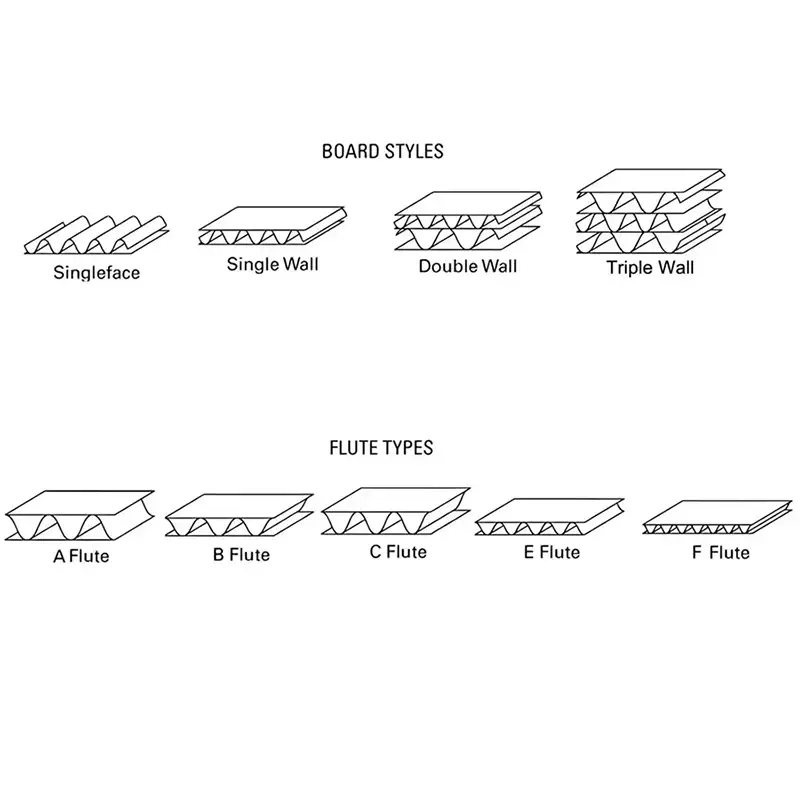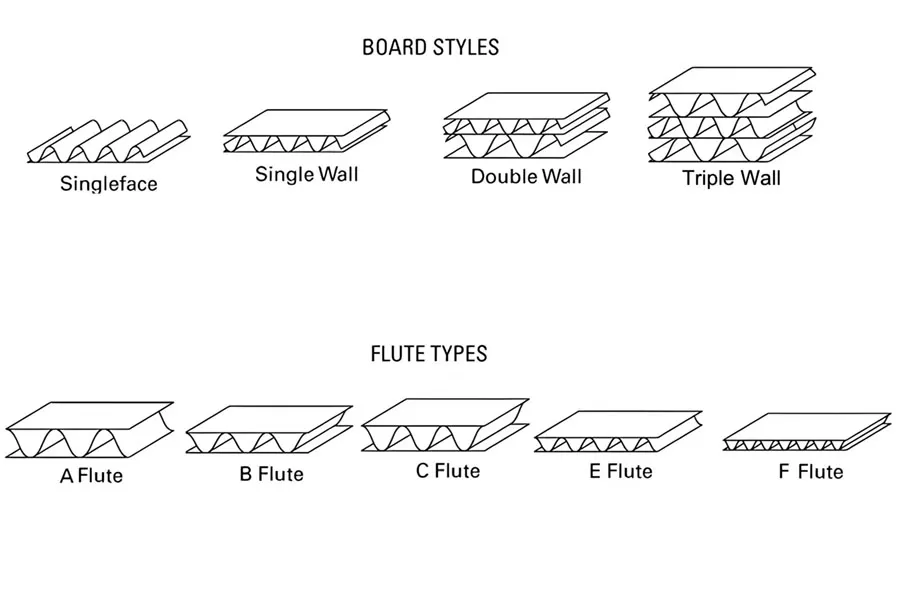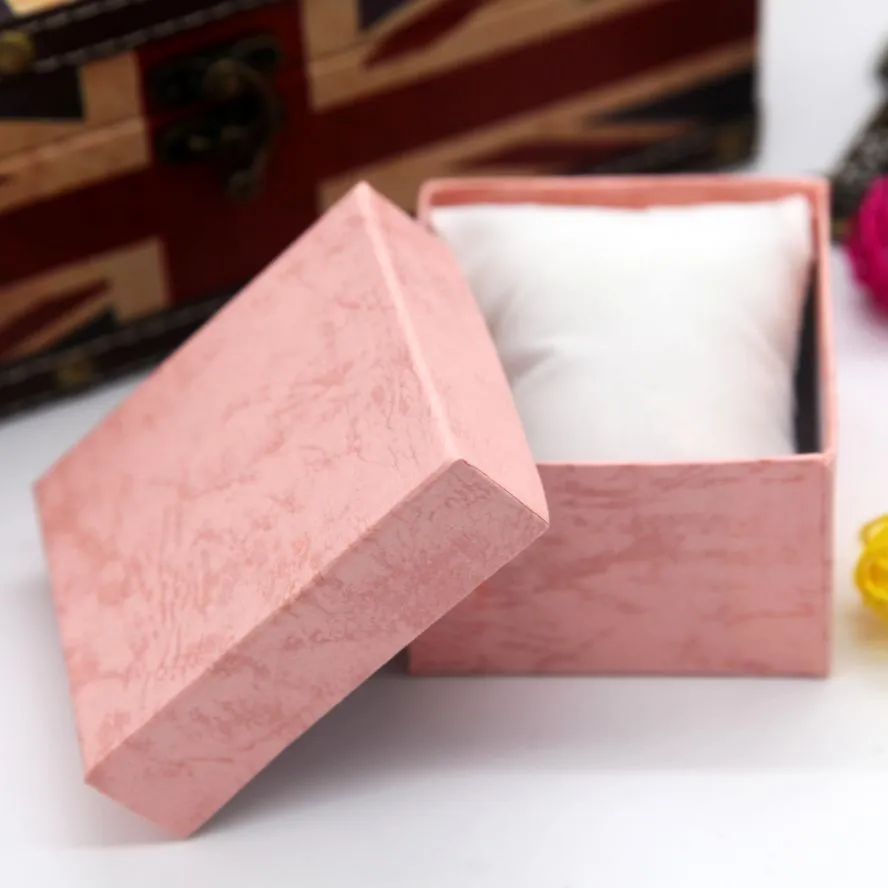The “Noodle Philosophy” of Corrugated Board: Choosing the Right Flute Type for Color Box Production Is Simpler Than You Think
In everyday applications of color box packaging, consumers are often drawn to the beautifully printed surface, paying little attention to the hidden "skeletal system" beneath — the flute structure of the corrugated board. This structure is the key to load-bearing, compression resistance, and print compatibility. The choice of flute type directly affects both the functionality and cost-effectiveness of the packaging. From the heavy-duty cartons used for transporting home appliances to the refined gift boxes for premium goods, each flute type acts like a precision gear, balancing strength, printability, and cost. For many seasoned shop-floor veterans, the rule of thumb — "fold, listen, and observe" — often reveals more about performance than a spec sheet ever could.
Flute Type Reference Chart
| Flute Type |
Actual Thickness (mm) |
Compression Strength (N/m²) |
Print Grade |
Hidden Characteristics |
Typical Application |
| A-Flute |
5.2 ± 0.3 |
≥ 8000 |
Grade 3 |
High moisture absorption |
Appliance outer boxes |
| B-Flute |
3.0 ± 0.2 |
5500 |
Grade 1 |
Excellent bending resistance |
Cosmetic inner trays |
| C-Flute |
4.1 ± 0.2 |
7000 |
Grade 2 |
Well-balanced properties |
Food gift boxes |
| E-Flute |
1.5 ± 0.1 |
3000 |
Premium |
Good heat resistance |
Mobile phone packaging |
| F-Flute |
0.8 ± 0.05 |
2000 |
Premium+ |
High flexibility |
Luxury inner supports |
Note: Print Grades – Premium = 200 lpi high definition; Grade 1 = 150 lpi; Grade 2 = 100 lpi; Grade 3 = 80 lpi
The “Five Senses” Inspection Method on the Workshop Floor
- Veteran technicians can assess flute quality without instruments:
- Sound Test: High-quality A-flute makes a crisp “click” when bent; low-grade boards emit a dull thud.
- Visual Inspection: E-flute should show a uniform matte finish under 45° lighting.
- Touch the Waves: B-flute should have 112 ± 3 flutes per 30 cm length.
- Smell the Paper: Food-grade C-flute has a faint pulp aroma; a sharp acidic smell may indicate excessive adhesive.
- Weight in Hand: A standard F-flute board (100 × 80 cm) should weigh about 380 ± 20 g.
Three Practical Flute Selection Tips
- Proven rules of thumb from the shop floor:
- “Check the weight”:
- Over 5 kg → choose A or C-flute;
- Around 3 kg → B-flute;
- Under 1 kg → E-flute is best.
- “Feel the surface”:
- For high-definition printing → go with B or E-flute;
- For standard graphics → use C-flute;
- For plain shipping boxes → A-flute is sufficient.
- “Consider the value”:
- For valuable goods → use E-flute on the outside and A-flute inside;
- For regular products → single-layer C-flute is most cost-effective.
Classic Flute Combinations
- Like mixing and matching outfits, flute combinations can be styled for specific purposes:
- AB Flute (Business Combo):
- Outer B-flute + Inner A-flute.
- Ideal for appliance packaging — refined appearance outside, strong support inside.
- BC Flute (Casual Fusion):
- Often used for tea gift boxes — C-flute outside for moisture resistance, B-flute inside for shape protection.
- BE Flute (Luxury Combo):
- A favorite in cosmetic packaging — E-flute outside for a premium look, B-flute inside for structural integrity.
Special Application Scenarios
- Case 1: Seafood Cold Chain Packaging
- Uses a “BC combo with PE coating” structure:
- Outer B-flute resists condensation (20% denser flute pattern)
- Inner C-flute provides support (wax-treated)
- Middle PE film for leak resistance
- Cost increases by 15%, but damage rate drops from 12% to 1.8%
- Case 2: Anti-Static Electronics Packaging
- On E-flute surface, apply:
- 0.03 mm conductive carbon layer (surface resistance: 10⁴ Ω)
- Aluminum foil shielding (attenuation ≥ 30 dB)
- Replaces traditional anti-static bags, reducing cost by 40%
- Case 3: Recyclable Shipping Boxes
- Uses a “sandwich structure”:
- Top layer: F-flute (print surface)
- Middle layer: honeycomb paperboard (cushioning)
- Bottom layer: C-flute (load-bearing)
- Reusable up to 20 cycles
Three Hidden Cost-Saving Tips
1. Scrap Optimization
- A-flute offcuts → repurposed into E-flute pads
- B-flute waste → compressed into filler material
- Monthly waste reduction: 2–3%
2. Humidity Control Pitfalls
- C-flute must enter humidity-controlled room 24 hours before processing during rainy seasons
- E-flute should be printed within 2 hours of cutting
- Proper control can reduce process waste by 3%
3. Die-Cutting Secrets
- Ideal die angle for A-flute: 22°
- E-flute requires imported alloy dies (5× lifespan)
- Proper tooling can boost die-cutting speed by 30%
Quick-Fix Manual for Common Issues
Issue 1: Paperboard Cracking
- Emergency Fix: Heat area with an 80°C hot air gun and roll to press
- Prevention: Move boards to the workshop environment 12 hours in advance during winter
Issue 2: Print Ghosting
- Quick Solution: Apply 3M removable tape on feeder rollers
- Long-Term Fix: Switch to anti-slip coated boards
Issue 3: Lamination Peeling
- Emergency Fix: Spot-apply modified starch glue using a syringe
- Root Cause Solution: Adjust hot plate temperature to 105 ± 2°C
Conclusion
Flute type selection in corrugated board is a practice that blends materials science with hands-on experience. From the load-bearing A-flute to the ultra-thin, highly printable F-flute, each type plays a unique role in specific packaging scenarios. In production, success depends not only on mastering advanced flute combinations but also on managing hidden cost drivers like humidity and die-cutting. As micro-flutes and eco-materials gain popularity, traditional selection logic is being redefined. True masters of the craft understand the “personality of paper,” achieving a perfect balance between mechanics and aesthetics through the touch of a finger and a glance at a wave pattern — that’s the enduring wisdom of color box manufacturing.




 We like to do design according to all the customers' requirements, or offer them our new designs. With strong OEM/ODM capabilities, we can fill your sourcing demands.
We like to do design according to all the customers' requirements, or offer them our new designs. With strong OEM/ODM capabilities, we can fill your sourcing demands.